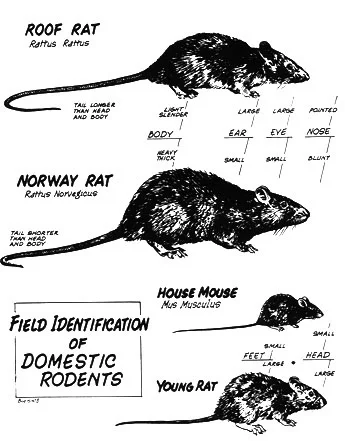NORWAY RAT
What is a BROWN / NORWAY Rat
Norway rats are husky, brownish type of rats that weigh about 11 ounces. Different than a roof rat, Brown rats are about 13 to 18 inches long including the 6 to 8 1/2 inch tail. Their fur is coarse and mostly brown with scattered black on the upper surfaces. The underside is typically grey to yellowish-white, and are very prone to getting into your roof, often leading to the need of roof repairs.
Rats will eat nearly any type of food, but they prefer high-quality foods such as meat and fresh grain. Rats require 1/2 to 1 fluid ounce of water daily when feeding on dry food. Rats have keen taste, hearing and sense of smell. They will climb to find food or shelter, and they can gain entrance to a building through any opening larger than 1/2 inch across.
Rats have litters of 6 to 12 young, which are born 21 to 23 days after mating. Young rats reach reproductive maturity in about three months. Breeding is most active in spring and fall. The average female has four to six litters per year. Rats can live for up to 18 months, but most die before they are one year old.
Norway rats will eat nearly any type of foods; however, they prefer a balanced diet of cereal grains, meats, fish, nuts, and fruits. They require 0.5 to 1 ounce of water daily when feeding on dry foods but require less when moist foods are available. Norway rats frequent household garbage due to the choice of a balanced diet and the availability of moist foods. They are usually active around dusk and may be seen during the daylight in cases of heavy infestations. Their droppings are blunt and about the same shape and size of a dry raisin.
The Norway rat is usually nocturnal. It is a good swimmer, but unlike the related Black rat (Rattus rattus), it is a poor climber. Norway rats dig well, and often excavate extensive burrow systems.
Rats are capable of producing ultrasonic vocalizations both as adults and pups. They may also emit short, high frequency, socially-induced vocalization during interactions with other rats or animals. This call most resembles a “chirping” sound, but is undetectable to human ears. Rats can audibly be heard through calls resembling “squeaks” when they are in distress.
Rats are omnivores. This means they can prey on both plants and animals. As predators, rats are very opportunistic.
Norway rats live in large hierarchical groups, either in burrows or subsurface places such as sewers and cellars. When food is in short supply, the rats lower in social order are the first to die. If a large fraction of a rat population is exterminated from an area, the remaining rats will increase their reproductive rate, and quickly restore the old population level. This makes it important to have a well thought out and aggressive eradication and prevention plan, one that does not leave any survivors and also does not allow recolonization from elsewhere.
NORWAY Rat Size
A avg roof rat’s size is 13 to 18 inches long. Some roof rats can weigh well over 9 ounces.
NORWAY rat droppings
click below to see if the feces you found isn’t from roof rats
nORWAY rats texas
How to handle dead rats, rat droppings, and nesting areas
Use rubber gloves.
Ventilate the affected area the night before cleanup by opening doors and windows.
Spray dead rats, droppings, nests and surrounding areas with a 10% bleach solution (one part bleach and 9 parts water). Allow at least 15 minutes of contact time before removal.
Clean the affected area with paper towels or a mop. DO NOT SWEEP OR VACUUM. Double bag both the disinfectant-soaked rat and cleanup materials securely in plastic bags and seal. Dispose in city trash containers.
Before removing gloves, wash in disinfectant, then soap and water. Dispose of gloves with other household waste. Thoroughly wash hands with soap and water.
Norway Rats
Characteristic: Large, robust
Adult size: 7-18oz/200-500g
Length: ((nose to tip of tail): 7-9.5in/18-25cm
Snout: Blunt
Ears: Small, covered with short hairs; do not reach eyes
Eyes: Small
Tail: Dark above, pale beneath
Fur: Brown with scattered black; abdomen -gray to yellow-white;shaggy
Droppings: Capsule shaped, 2cm/3/4-1 inch
Senses:
Sight: Poor,color blind
Smell, Taste, Touch, Hearing: Excellent
Food: Omnivorous(22-30grams/day) 0.8-1 oz.
Water: 15-30 ml/day
Feeding Habits: Shy (new object reaction);steady eater
Climbing: Readily climbs, limited agility
Nests: Usually burrows
Swimming: Excellent swimmer
Home Range Radius: 30-50 m/98-164 ft.
Age at mating (months): 2-3
Breeding season: Spring and Fall peaks
Gestation period (days): 22
Young per litter: 8-12
Litters per year: 4-7
Young weaned/female/year: 20
Length of life: 1 year



